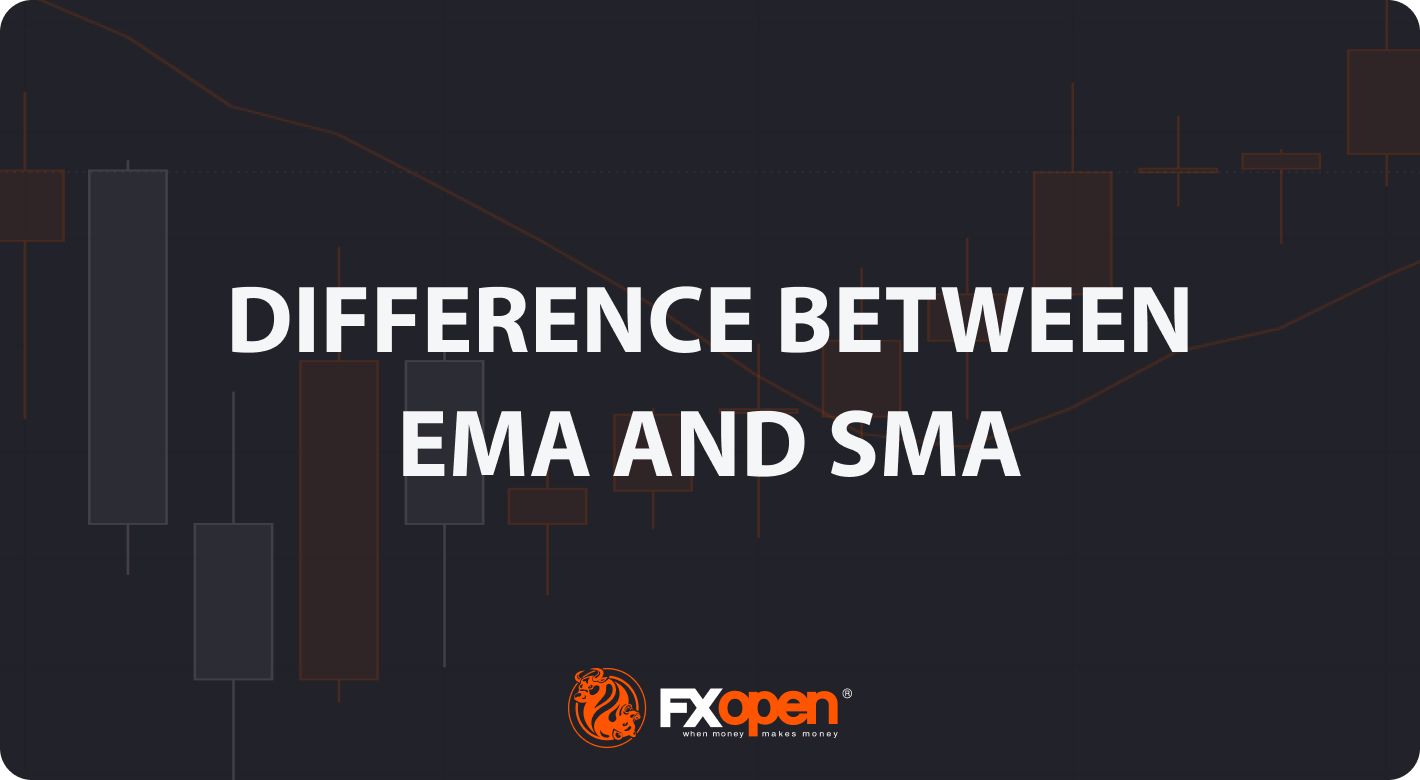FXOpen

In the dynamic world of trading, where precision and insight are paramount, traders wield an extensive toolkit to navigate the ever-evolving financial landscape. Technical analysis emerges as a pivotal resource in this arsenal, enabling traders to dissect historical price data, identify chart patterns, and grasp the prevailing market direction. This FXOpen article aims to explore the simple moving average vs the exponential moving average, offering valuable insights into how these two distinct indicators can be employed to decipher and anticipate market trends.
What Is a Simple Moving Average?
A simple moving average (SMA) is a statistical calculation used in various fields, including finance and data analysis, to analyse and smooth out time-series data, such as stock prices, sales figures, and temperature readings. It is a basic and widely used method for calculating an average value over a specified period of time.
A simple moving average is reached by calculating the arithmetic mean of a set of data points over a specified period of time.
In trading, the SMA is widely used to:
- Identify Trends: The SMA helps traders identify the trend direction. When the indicator is sloping upwards, it suggests an uptrend, and when it's sloping downwards, it indicates a downtrend.
- Find Buy and Sell Signals: SMA crossovers, where short-term and long-term lines intersect, can signal potential buy or sell opportunities. The rule is simple: when a short-term line breaks above the longer-term, it may be considered a buy signal. Conversely, when a short-term line falls below the longer-term, it may be a sell signal.
- Determine Support and Resistance Levels: SMAs can be used as dynamic support and resistance. The price may rebound upwards from the MA in a strong uptrend or downwards in a strong downtrend. A cross below the MA in a bullish trend or above the MA in a bearish trend will signal a trend change.
What Are the Pros and Cons of the Simple Moving Average?
Undoubtedly, the SMA is one of the most popular trading tools. However, it has pitfalls that every trader should be aware of.
Advantages:
- Simplicity: It is easy to calculate and understand, making the SMA suitable for traders of all experience levels.
- Smoothed Data: The indicator provides smoothed price data, reducing noise and making it easier to identify trends.
Disadvantages:
- Lagging Nature: It lags behind current market prices, potentially causing delayed signals.
- Equal Weighting: It gives equal weight to all data points in the calculation, which may not be ideal for capturing short-term price fluctuations.
What Is an Exponential Moving Average?
An exponential moving average (EMA) is another type of MA. It is similar to the simple moving average, but it gives more weight to recent data points, making it more responsive to changes in a data series. This responsiveness makes the EMA particularly useful for tracking trends and identifying turning points in data, especially on low timeframes.
*K is a weighting multiplier.
Traders use the EMA for similar purposes as the SMA but with a focus on short-term trends. It is particularly useful when:
- Quick Reactions Are Needed: It reacts faster to recent price changes, making it suitable for traders who want to capture short-term price movements.
- Confirming Trends: It can help confirm the strength and direction of a trend in real time.
What Are the Pros and Cons of the EMA?
The exponential moving average is widely used by traders, but it has limitations that should be considered before making a decision.
Advantages:
- Quick Response: It reacts swiftly to price changes, making it valuable for traders who need timely information.
- Weighted to Recent Data: It gives more importance to recent prices, which is beneficial for short-term traders.
Disadvantages:
- Complex Calculation: Its calculation involves more complexity than the SMA.
- Increased Noise: As it is sensitive to short-term fluctuations, it may generate more false signals in choppy markets.
What Are the Key Contrast Points Between SMA vs EMA?
The differences between SMA and EMA can be classified as follows:
- Weighting: The SMA gives equal weight to all data points, while the EMA assigns more weight to recent data, making it more responsive to short-term price changes.
- Responsiveness: The EMA reacts faster to market changes, leading to quicker trend identification, but it can also generate more false signals in choppy markets.
The comparison between the exponential moving average vs simple moving average highlights their value as essential tools for traders to analyse and interpret market trends. As mentioned above, traders often use SMA or EMA to gain a more comprehensive view of market dynamics. You can test both indicators on the TickTrader platform. Additionally, you can open an FXOpen account to trade various instruments with low spreads and commissions.
FAQ
How can traders effectively utilise EMA vs SMA in stocks to make informed trading decisions?
Traders often use the EMA for short-term stock price analysis as it provides rapid responses to recent price changes, while the simple moving average is better suited for longer-term trend identification as it provides a smoother and less noisy indication. The choice between the simple vs exponential moving average depends on the trader's preferred trading style and timeframe.
What are the key considerations when deciding between the EMA vs SMA for day trading strategies?
In day trading, the exponential moving average is favoured for its responsiveness to short-term price changes, offering timely signals for capturing intraday movements, while the SMA is better suited for longer-term trend analysis as it effectively confirms established trends but has a price lag.
This article represents the opinion of the Companies operating under the FXOpen brand only. It is not to be construed as an offer, solicitation, or recommendation with respect to products and services provided by the Companies operating under the FXOpen brand, nor is it to be considered financial advice.
Stay ahead of the market!
Subscribe now to our mailing list and receive the latest market news and insights delivered directly to your inbox.








